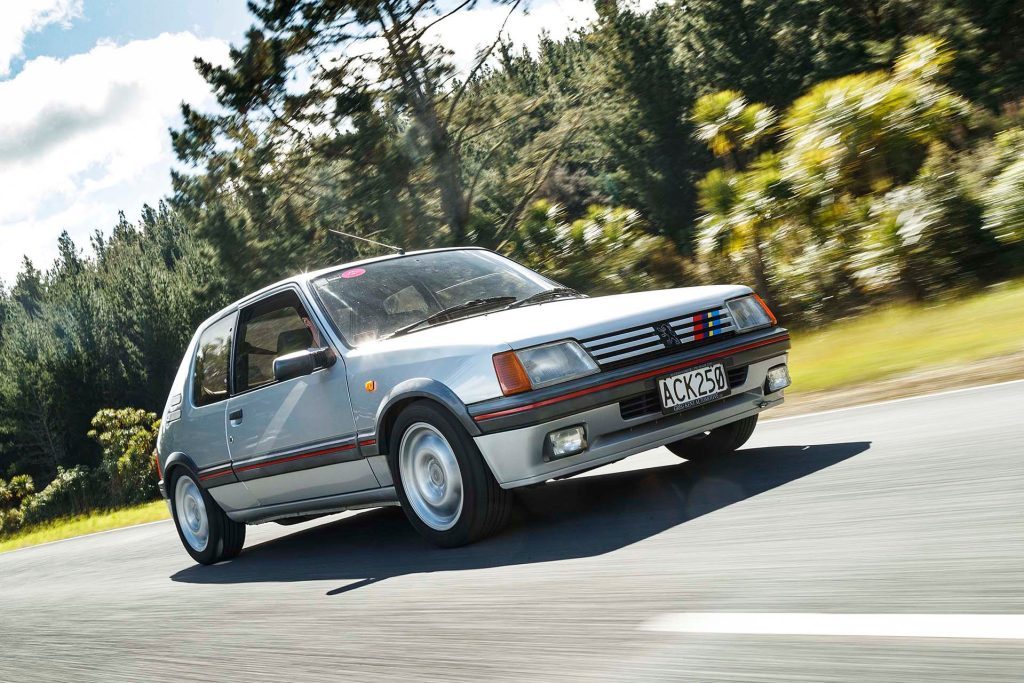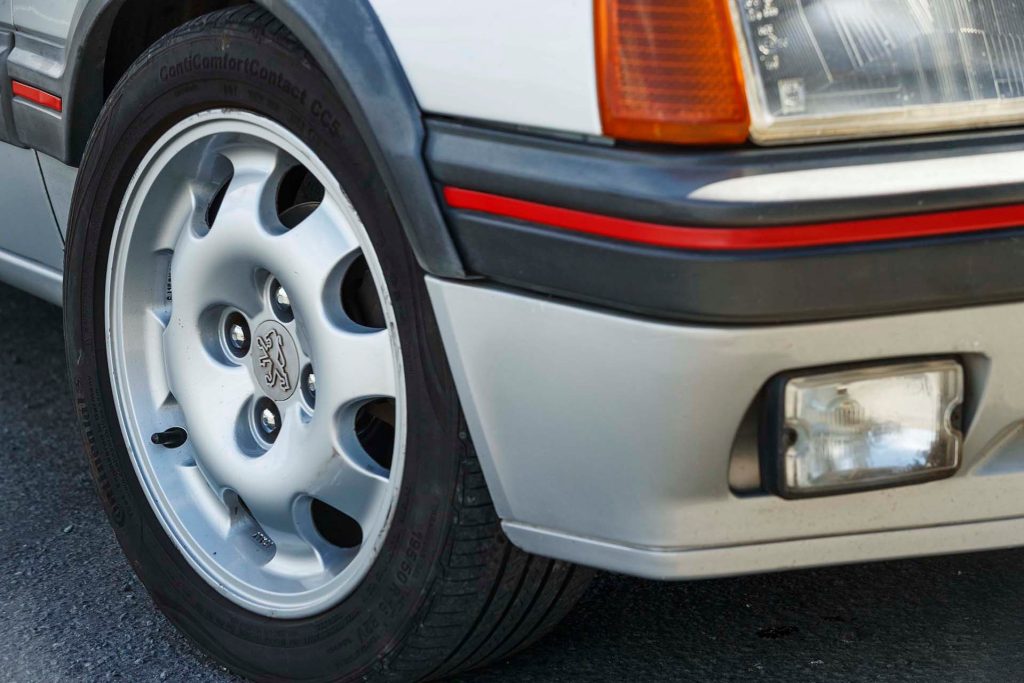1990 Peugeot 205 GTi
Words: Kyle Cassidy | Photos: Tom Gasnier
Touted as one of the best hot hatches ever, the Peugeot 205 GTi was a revelation when it burst onto the scene in the mid-eighties. We check out a rare, NZ-new model with a bit of a surprise under the bonnet.
Pose the question ‘what’s the best hot hatch ever?’ and the debate could rage on all day. This go-fast automotive theme has evolved over the decades but back when it was a novel idea the recipe was simple. To keep costs in check, manufacturers souped up a run-of-the-mill model with an injection of horsepower (usually via a bigger engine plucked from the model line above) and threw some development money at upgrading the handling, braking and styling. Most mass market brands have had a crack at it at some point, but not all have risen to the heights.

The GTi badge is one that has adorned a few hot hatches from various companies and comes from a time when the ‘i’ meant something. It (usually) signaled the adoption of fuel injection, something often reserved for top models of the day. And when coupled with an increase in engine capacity, the more precise fuel delivery method gave the hot hatch a decent uptick in power and torque.

Back in the mid 1980s, Peugeot slapped the GTi badge on a few of its models, the first being the V6-powered 604 in 1983, a year before the sprightly 205 GTi debuted. New for 1983, the 205 was a revelation for the firm, replacing the dowdy-looking 104. The new car was well packaged thanks to its compact engine (slanted back 30 degrees with the exhaust manifold flowing from the rear) and its independent rear suspension arrangement. With trailing arms and torsion bars, this gave the small car good rear passenger room and boot space. It also contributed to the model’s entertaining dynamics.

So it was a good platform for Peugeot to spring a hot hatch from. The first GTi appeared in 1984 fitted with a 1.6-litre injected engine making 77kW. That’s not a lot in the scheme of things but with lesser models in the 205 range having between 40 and 60kW, it was a decent step up. Coupled with its sub-900kg kerb weight, it was a goer. In 1987, the 1.6 received a new head with larger valves to take power to 86kW. Along with complementary chassis tweaks, the GTi was praised for its lively, communicative handling, with plenty of throttle adjustability. In 1986, Peugeot added more firepower to the recipe with a larger 1.9 model which brought 94kW and more midrange torque. And amongst the Pug GTi enthusiasts (all of which would say the 205 is the best hot hatch ever) the debate between which car is better is a hot topic.

For the owner of this 205 GTi, Aucklander Richard McCarthy, it would have to be the 1.9. “I think it’s more desirable, being the top spec with the bigger motor. I know many think the 1.6 is the better car because it feels more peppy but it’s more to do with the gearbox as the 1.6 has shorter ratios.”

This is Richard’s first car, having bought it in 2015. “I’ve always liked classic cars as my family has raced classics all my life. My dad and uncle decided to get into the 2K Cup for a bit of a laugh and they bought a white 205 GTi and I thought to myself that’s what I want. I love French cars.”

This car is somewhat of a rarity here being a New Zealand new model (sans the usual sunroof and catalytic converter) as the majority of local 205s were first registered in Japan. It’s only had a few owners too, which is key to these old things surviving in good condition. “The last owner was well off and would throw money at it. I have receipts from the early 2000s when they were spending $1000 on this and that in maintenance.”


Still that didn’t prevent the engine from eventually doing its head gasket.


“We did the rebuild ourselves. It is not a complex motor with just the single overhead cam and as my Dad and uncle had rebuilt their racing engine, we knew what we were doing.”

Somewhat ironically, this GTi is actually a GTc, having been converted to a carb set up. “We had some bits laying around from when Dad had carb’d one of his other engines and they fitted nicely. I still have all the original bits, so it’s all reversible. I haven’t done any permanent changes.”

But we have to ask why? “I did it purely for the sound. Having driven it for three or so years on injection, the carbs make it feel more lively, more awake. That was always the one thing you read online about the 1.9 engine versus the 1.6; they say the bigger engine is lazier. But the carbs make this want to go, the throttle response is now much sharper and it’s happier to rev.”

Richard says that he wouldn’t own a car like this without having his Dad’s mechanical knowledge. “He knows carbs from his racing Escorts. I’ll be sitting there warming it up and he says ‘your idle is a bit out’, and he quickly sorts it.”

When the engine needed its rebuild, there was the option to swap it for the 16-valve unit from the M16i. “I was talked out of that. It’s a bit of an internal struggle. I want to do things to it but at the same time, I know I shouldn’t. It’s my first car and as a student I can’t really afford to do anything else. It’s as I like it now, on the budget I can afford.”

While he drove it daily for about four years, it’s now reserved for the weekends. “I drive a Nissan Wingroad now… I didn’t want to put too many more miles on it. And it’s French. In winter it doesn’t want to start…it can be a headache but I love it.”



Richard says it’s had a few wiring problems too; “there are definitely suspect electronics in French cars”. While the car still has its ‘Bosch security system’ the factory radio had to be replaced. “It stopped working and then so did the one I replaced it with. That’s French wiring at it again.”

Despite this, he still loves the 205. “It’s simple and that’s what makes it so fun. It’s bare bones but it gives you a raw drive experience. I’d like to take it to a track day but I’m a little nervous about ragging on it. The pick-up in the oil sump is off to one side, and they are not baffled.” The last thing he needs is another rebuild bill.

Along with the usual rarity of parts, Richard says sourcing tyres is problematic in the original 185/55R15 as you can only get either Eco treads or sport/track rubber, so it now wears a wider 195 and is sitting a little lower than stock on Spax suspension.

The value of the 205 GTi has escalated in NZ since Richard bought his. “I managed to buy this for $4500 but I’ve recently had it appraised for nearly $20k.

“At this stage, the only reason I’d sell it is to buy a house one day. I don’t want to ever sell it though.”





